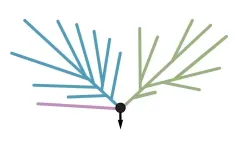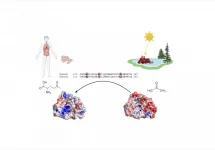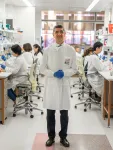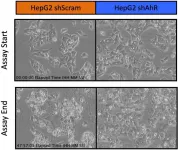(Press-News.org) Skoltech scientists have created a new monitoring system for agricultural applications that performs real-time image segmentation on board the drone to identify hogweed. The research was published in a high-profile journal, IEEE Transactions on Computers.
Sosnovsky's hogweed is equally hazardous for farming, local ecosystems, and human health. Direct contact with human skin, especially if aggravated by exposure to the Sun, causes severe burns that require continuous medical care and take weeks to heal. The rampant spread of Sosnovsky's hogweed has become a real environmental disaster that extends across the whole of Russia, from its central part to Siberia and from Karelia to the Caucasus. Every year, the government allocates huge budgets (last year, 350 million rubles for Moscow alone) for hogweed elimination. Eradicating the poisonous plant has become one of the biggest challenges for Russian farming, environment, and healthcare.
In the mid-20th century, there were plans to use hogweed as a fodder crop, given its quick growth, low maintenance requirements, and fast proliferation. However, it soon transpired that hogweed was no good as a livestock feed and its exceptional natural properties were a major problem rather than an advantage. One plant can produce up to 100,000 seeds per year, which are easily dispersed by the wind. This means that a single plant accidentally left behind makes the clearing operation utterly pointless.
Accurate real-time localization of hogweed was the first issue that researchers from the Skoltech Center for Computational and Data-Intensive Science and Engineering (CDISE) encountered when they started developing their monitoring platform two years ago. "Conventional monitoring methods are not effective enough, since ground observations are highly dependent on the human factor, while space remote sensing can spot large thickets only. Satellite images do not have sufficient resolution to discern individual plants. Besides, traditional monitoring strongly depends on weather and satellite revisit periods and, therefore, cannot provide up-to-date information," lead author and Skoltech PhD graduate Alexander Menshchikov explains.
The researchers decided to use drones that are able to capture up-to-date high-resolution hogweed images even in cloudy weather and opted for in-flight data acquisition and processing on board the drone instead of the classical "data capture - orthophotomap - data analysis" scheme. "Even though the traditional approach provides exhaustive information about the area, it is nearly as effective as processing data on board with segmentation for one type of object, i.e. Sosnovsky's hogweed. Besides, in the traditional method, after-flight image stitching and analysis takes several hours, whereas in-flight processing produces real-time data which are immediately downloaded to the base station, so that the clearing of the targeted area could start before the drone lands," Alexander adds.
The new monitoring solution uses a drone and a compact on-board computer which runs "heavy" segmentation algorithms based on Fully Convolutional Neural Networks (FCNN) that can identify an irregularly shaped object (in this case, Sosnovsky's hogweed) pixel-by-pixel. This will help to discern individual plants and raise the chances of killing all the weeds in the selected area.
Running FCNNs on low-power hardware, such as single-board computers (SBC), was the main hindrance for the project. Since there are only a limited number of computers that have sufficient resources and processors that support FCNN, the researchers had to find a suitable SBC architecture and optimize FCNN to make it run on the selected hardware version.
"We chose popular architectures, UNet, SegNet, and ResNet, for our neural networks and adapted them for the SBC. We installed and flight-tested our monitoring system on board the drone which covered an area of up to 28 hectares in 40 minutes, flying at an altitude of 10 meters. And it did not miss a single weed!" Skoltech assistant professor and project supervisor Andrey Somov comments.
"Our system displays a multifold increase in localization efficiency, even though it processes 4K images at a modest speed of 0.7 fps," Andrey adds.
The new approach holds great promise for farming: it could be used to monitor other crops, identify various vegetative indicators, assess plant health and detect plant diseases by applying multispectral imagery.
INFORMATION:
The hogweed project is a collaborative study involving MSc and PhD students and researchers of several Skoltech centers: CDISE, CDMM (Skoltech Center for Design, Manufacturing and Materials), and SSC (Skoltech Space Center): Alexander Menshchikov, Dmitry Shadrin, Viktor Prutyanov, Daniil Lopatkin, Sergey Sosnin, Evgeny Tsykunov, Evgeny Yakovlev, and Andrey Somov.
Skoltech is a private international university located in Russia. Established in 2011 in collaboration with the Massachusetts Institute of Technology (MIT), Skoltech is cultivating a new generation of leaders in the fields of science, technology and business, is conducting research in breakthrough fields, and is promoting technological innovation with the goal of solving critical problems that face Russia and the world. Skoltech is focusing on six priority areas: data science and artificial intelligence, life sciences, advanced materials and modern design methods, energy efficiency, photonics and quantum technologies, and advanced research. Web: https://www.skoltech.ru/.
Individuals with diabetes are at greater risk of developing oral health issues, like gum disease, yet care for these linked health issues are usually disconnected, split between primary care and dental care. A research team from the University of Amsterdam developed an intervention that provided primary care-based oral health information and dental referrals for patients with diabetes. In a cluster randomized controlled trial, 764 patients from 24 primary care practices received either the oral health support or standard primary care. Participants were asked to rate their oral health quality of life, as well as their general health and any oral health complaints, at the start and end of the study. Analysis showed that individuals who received the primary care-based oral health support ...
Though different fabrication approaches exist, two-step deposition is one of the main experimental techniques now used to make efficient, stable PSCs, especially on the industrial scale. The process involves first depositing lead iodide (PbI2) and then adding halide salts of monovalent cations such as methylammonium iodide (MAI) and formamidinium iodide (FAI) to convert it to perovskite.
While this two-step deposition is better than other options, it is difficult to maintain reproducible high performance and long-term stability when scaling up, mostly because of a lack ...
EAST LANSING, Mich. - An acute loss of smell is one of the most common symptoms of COVID-19, but for two decades it has been linked to other maladies among them Parkinson's disease and dementia. Now, a poor sense of smell may signify a higher risk of pneumonia in older adults, says a team of Michigan State University researchers.
"About a quarter of adults 65 years or older have a poor sense of smell," said Honglei Chen, a professor in the Department of Epidemiology and Biostatistics within MSU's College of Human Medicine. "Unlike vision or hearing impairment, this sensory deficit has been largely neglected; more than two-thirds of people with a poor sense of smell do not know they have it."
In a first-of-its-kind study, Chen and his team found a possible link ...
Simon Fraser University researchers have designed a remarkably fast engine that taps into a new kind of fuel -- information.
The development of this engine, which converts the random jiggling of a microscopic particle into stored energy, is outlined in research published this week in the END ...
Scientists now better understand early bacterial evolution, thanks to new research featuring University of Queensland researchers.
Bacteria comprise a very diverse domain of single-celled organisms that are thought to have evolved from a common ancestor that lived more than three billion years ago.
Professor Phil Hugenholtz, from the Australian Centre for Ecogenomics in UQ's School of Chemistry and Molecular Biosciences, said the root of the bacterial tree, which would reveal the nature of the last common ancestor, is not agreed upon.
"There's great debate about the root of this bacterial tree of life and indeed whether bacterial evolution should even be described as a tree has been contested," Professor ...
Just a few changes to an enzyme's amino acids can be enough to dramatically change its function, enabling microbes to inhabit wildly different environments.
University of Queensland microbiologist Associate Professor Ulrike Kappler, led by an international team of researchers, made this discovery when investigating how Haemophilus influenzae bacteria colonise the human respiratory system.
"This disease-causing bacterium is supremely adapted to living in humans, so much so that they cannot survive anywhere else," Dr Kappler said.
"It turns out that one enzyme, MtsZ, is the key player in this adaptation.
"But, surprisingly, ...
Researchers have been able to reduce scarring by blocking part of the healing process in research that could make a significant difference for burns and other trauma patients.
University of Queensland Professor Kiarash Khosrotehrani said scars had been reduced by targeting the gene that instructs stem cells to form them in an animal study.
"The body's natural response to trauma is to make plenty of blood vessels to take oxygen and nutrients to the wound to repair it," Professor Khosrotehrani said.
"Once the wound has closed, many of these blood vessels become fibroblast cells which produce the collagens forming the hard materials found in scar tissue.
"We found that vascular stem cells determined whether a blood vessel was retained or gave rise to scar material ...
CORVALLIS, Ore. - A team of Oregon State University scientists has discovered a new class of anti-cancer compounds that effectively kill liver and breast cancer cells.
The findings, recently published in the journal Apoptosis, describe the discovery and characterization of compounds, designated as Select Modulators of AhR-regulated Transcription (SMAhRTs).
Edmond Francis O'Donnell III and a team of OSU researchers conducted the research in the laboratory of Siva Kolluri, a professor of cancer research at Oregon State. They also identified the aryl hydrocarbon receptor (AhR) as a new molecular target ...
Researchers looking to help people suffering from addiction, depression, and pain are studying how certain brain neurons operate to see if they can be controlled.
In a paper published May 11 in Neuron, researchers at the University of Washington School of Medicine and Washington University in St. Louis, along with several other universities, successfully used a protein called parapinopsin to turn off brain circuits. This protein is found in lamprey - an ancient lineage of jawless fish similar to eel. Reserachers said the ability to inhibit neurons could eventually lead to turning ...
BUFFALO, N.Y. - Americans are in chronic pain, and a comprehensive new study exploring trends in this major public health concern reveals that what has been a long-standing and under-acknowledged problem is getting substantially worse.
The findings, published in the latest issue of the journal Demography, suggest blanket increases across multiple measures, with pain rising in every adult age group, in every demographic group, and at every site of pain for which data exists. People today are experiencing more pain than individuals of the same age in earlier decades. In fact, each subsequent birth group is in greater pain than the one that came before it.
"We ...





